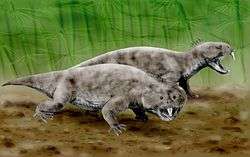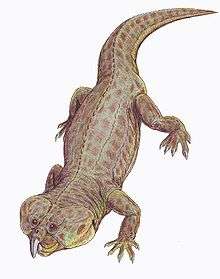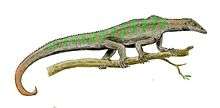Hyperodapedon
| Hyperodapedon Temporal range: Late Triassic, 231–216 Ma | |
|---|---|
 | |
| Scientific classification | |
| Kingdom: | Animalia |
| Phylum: | Chordata |
| Class: | Reptilia |
| Order: | †Rhynchosauria |
| Family: | †Rhynchosauridae |
| Subfamily: | †Hyperodapedontinae |
| Genus: | †Hyperodapedon Huxley, 1859 |
| Species | |
| |
| Synonyms | |
|
Genus-level:
Species-level:
| |
Hyperodapedon is a genus of rhynchosaur (a beaked, archosaur-like reptile) from the late Triassic period (Carnian stage).
Discovery

The type species of Scaphonyx (meaning canoe claw), Scaphonyx fischeri that once thought to be a dinosaur, is now known to be based on dubious material and therefore should be a nomen dubium. The name Paradapedon was elected for the Indian species H. huxleyi (Lydekker, 1881). Benton, 1983, concluded that this rhynchosaur should be considered a species of Hyperodapedon.
Hyperodapedon is known from several species and has been found in many areas of the world, due to the continents being joined together in the supercontinent Pangaea during the Triassic. Fossils from the various species have been identified from Argentina, Brazil, India, Scotland and possibly from Canada, United States and Wyoming. It was hunted by many predators like Saurosuchus and Prestosuchus.
Description
Hyperodapedon was a heavily built, stocky, animal around 1.3 metres (4.3 ft) in length. Apart from its beak, it had several rows of heavy teeth on each side of the upper jaw, and a single row on each side of the lower jaw, creating a powerful chopping action when it ate. It is believed to have been herbivorous, feeding mainly on seed ferns, and died out when these plants became extinct at the end of the Triassic.[1]
Langer et al. (2000) defined Hyperodapedon as a stem-based taxon that includes all rhynchosaurs closer to Hyperodapedon gordoni than to "Scaphonyx" sulcognathus (now Teyumbaita).[2] The cladogram below follows their phylogenetic analysis of Mukherjee & Ray (2014).[3]
| Hyperodapedontinae |
| |||||||||||||||||||||||||||||||||||||||||||||||||||||||||||||||
| |
Valid species that were first assigned to Scaphonyx.
References
- ↑ Palmer, D., ed. (1999). The Marshall Illustrated Encyclopedia of Dinosaurs and Prehistoric Animals. London: Marshall Editions. p. 92. ISBN 1-84028-152-9.
- ↑ Max C. Langer and Cesar L. Schultz (2000). "A new species of the Late Triassic rhynchosaur Hyperodapedon from the Santa Maria Formation of south Brazil". Palaeontology. 43 (6): 633–652. doi:10.1111/1475-4983.00143.
- ↑ Mukherjee, D., Ray, S. (2014), A new Hyperodapedon (Archosauromorpha, Rhynchosauria) from the Upper Triassic of India: implications for rhynchosaur phylogeny. Palaeontology. doi: 10.1111/pala.12113

